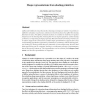Free Online Productivity Tools
i2Speak
i2Symbol
i2OCR
iTex2Img
iWeb2Print
iWeb2Shot
i2Type
iPdf2Split
iPdf2Merge
i2Bopomofo
i2Arabic
i2Style
i2Image
i2PDF
iLatex2Rtf
Sci2ools
ECCV
1998
Springer
1998
Springer
Shape Representations from Shading Primitives
Diffuse interreflections mean that surface shading and shape are related in ways that are difficult to untangle; in particular, distant and invisible surfaces may affect the shading field that one sees. The effects of distant surfaces are confined to relatively low spatial frequencies in the shading field, meaning that we can expect signatures, called shading primitives, corresponding to shape properties. We demonstrate how these primitives can be used to support the construction of useful shape representations. Approaches to this include testing hypotheses of geometric primitives for consistency with the shading field, and looking for shading events that are distinctive of some shape event. We show that these approaches can be composed, leading to an attractive process of representation that is intrinsically bottom up. This representation can be extracted from images of real scenes, and that the representation is diagnostic. 1 Background Changes in surface brightness are a powerful c...
Computer Vision | ECCV 1998 | Image Shading Starts | Local Shading Model | Shape Event | Shape Representation | Useful Shape Representations |
| Added | 16 Oct 2009 |
| Updated | 16 Oct 2009 |
| Type | Conference |
| Year | 1998 |
| Where | ECCV |
| Authors | John A. Haddon, David A. Forsyth |
Comments (0)

